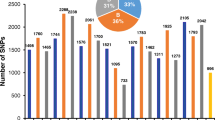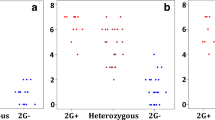Abstract
Hexaploid/tetraploid and tetraploid/hexaploid wheat hybrids were established using the hexaploid (Triticum aestivum L.) bread wheat LRC2010-150 and the tetraploid durum wheat (T. turgidum spp. durum) WID802. Thirty F2 progeny from each cross were characterised using Diversity Arrays Technology (DArTseq™) markers to determine whether there are differences between the crosses in the proportion of A, B and D genomic material inherited from each parent. Inheritance of the A and B genome from the tetraploid durum parent varied from 32 to 63% among the 60 lines assessed, and results indicated significant differences between the two F2 populations in the mean overall proportion of chromosomes A and B inherited from each parent. Significant differences were also observed between the crosses in the proportion of chromosomal segments on 2B, 3A, 3B and 4A inherited from the tetraploid parent. The F2 populations also showed significant differences in the average retention of D chromosomes per line with the tetraploid/hexaploid cross retaining a mean of 2.83 chromosomes while the reciprocal cross retained a mean of 1.8 chromosomes per line. A strong negative correlation was observed in individual lines from both populations between the proportion of the A and B genome inherited from the tetraploid durum parent and the retention of the D genome. The implication of these results for the design of efficient crossing strategies between hexaploid and tetraploid wheats is discussed.




Similar content being viewed by others
References
Bhagyalakshmi K, Vinod KK, Kumar M, Arumugachamy S, Prabhakaran A, Raveendran TS (2008) Interspecific hybrids from wild x cultivated Triticum crosses—a study on the cytological behaviour and molecular relations. J Crop Sci Biotech 11:257–262
Eberhard FS, Zhang P, Lehmensiek A, Hare RA, Simpfendorfer S, Sutherland MW (2010) Chromosome composition of an F2 Triticum aestivum X T. turgidum spp. durum cross analysed by DArT markers and MCFISH. Crop Pasture Sci 61:619–624
Gilbert J, Procunier J, Aung T (2000) Influence of the D genome in conferring resistance to Fusarium head blight in spring wheat. Euphytica 114:181–186
Gupta PK, Varshney R (2000) The development and use of microsatellite markers for genetic analysis and plant breeding with emphasis on bread wheat. Euphytica 113:163–185
Kalous J, Martin J, Sherman J, Heo H-Y, Blake N, Lanning S, Eckhoff J, Chao S, Akhunov E, Talbert L (2015) Impact of the D genome and quantitative trait loci on quantitative traits in a spring durum by spring bread wheat cross. Theor Appl Genet 128:1799–1811
Kihara H (1925) Weitere Untersuchungen über die pentaploiden Triticum-Bastarde. I Jpn J Bot 2:299–305
Kihara H (1982) Wheat studies retrospect and prospects, Kodansha Ltd, Tokyo
Kopecký D, Bartoš J, Lukaszewski AJ, Baird JH, Černoch V, Kölliker R, Rognli OA, Blois H, Caig V, Lübberstedt T (2009) Development and mapping of DArT markers within the Festuca-Lolium complex. BMC Genomics 10:473
Lanning SP, Blake NK, Sherman JD, Talbert LE (2008) Variable production of tetraploid and hexaploid progeny lines from spring wheat by durum wheat crosses. Crop Sci 48:199–202
Martin A, Simpfendorfer S, Hare R, Sutherland M (2013) Introgression of hexaploid sources of crown rot resistance into durum wheat. Euphytica 192:463–470
Martin A, Simpfendorfer S, Hare RA, Eberhard FS, Sutherland MW (2011) Retention of D genome chromosomes in pentaploid wheat crosses. Heredity 107:315–319
Padmanaban S, Zhang P, Hare RA, Sutherland MW, Martin A (2017) Pentaploid wheat hybrids: applications, characterisation, and challenges. Front Plant Sci 8:358. doi:10.3389/fpls.2017.00358
Ramsey J, Schemske DW (1998) Pathways, mechanisms, and rates of polyploid formation in flowering plants. Annu Rev Ecol Syst 29:467–501
Ren R, Ray R, Li P, Xu J, Zhang M, Liu G, Yao X, Kilian A, Yang X (2015) Construction of a high-density DArTseq SNP-based genetic map and identification of genomic regions with segregation distortion in a genetic population derived from a cross between feral and cultivated-type watermelon. Mol Gen Genomics 290:1457–1470
Riley R, Chapman V (1967) The inheritance in wheat of crossability with rye. Genet Res 9:259–267
Saghai-Maroof MA, Soliman KM, Jorgensen RA, Allard R (1984) Ribosomal DNA spacer-length polymorphisms in barley: Mendelian inheritance, chromosomal location, and population dynamics. Proc Natl Acad Sci U S A 81:8014–8018
Sharma HC, Gill BS (1983) Current status of wide hybridization in wheat. Euphytica 32:17–31
Somers DJ, Isaac P, Edwards K (2004) A high-density microsatellite consensus map for bread wheat (Triticum aestivum L.) Theor Appl Genet 109:1105–1114
Wang H, Liu D, Yan Z, Wei Y, Zheng Y (2005) Cytological characteristics of F2 hybrids between Triticum aestivum L. and T. durum Desf. with reference to wheat breeding. J Appl Genet 46:365–369
Xu L, Wang M, Cheng P, Kang Z, Hulbert S, Chen X (2013) Molecular mapping of Yr53, a new gene for stripe rust resistance in durum wheat accession PI 480148 and its transfer to common wheat. Theor Appl Genet 126:523–533
Zhang P, Friebe B (2009) FISH on plant chromosomes. In: Liehr T (ed) Fluorescence in situ hybridization (FISH)—application guide. Springer, Berlin Heidelberg, Berlin, Heidelberg, pp 365–394
Acknowledgements
We thank Dr. Cassy Percy for providing us with hexaploid bread wheat LRC2010-150 seed. Part of the work was financially supported by the Grains Research and Development Corporation, Australia. The authors would like to thank Dr. Kathleen L. Farquharson (Plant Editors) for her critical comments on this manuscript. Sriram Padmanaban acknowledges the support of an Australian Postgraduate Award.
Author information
Authors and Affiliations
Corresponding author
Electronic supplementary material
Supplementary Figure 1
(JPEG 271 kb)
Supplementary Figure 2
(JPEG 277 kb)
Supplementary Table 1
(PDF 27 kb)
Supplementary Table 2
(PDF 26 kb)
Supplementary Table 3
(PDF 134 kb)
Supplementary Table 4
(PDF 52 kb)
Rights and permissions
About this article
Cite this article
Padmanaban, S., Sutherland, M.W., Knight, N.L. et al. Genome inheritance in populations derived from hexaploid/tetraploid and tetraploid/hexaploid wheat crosses. Mol Breeding 37, 48 (2017). https://doi.org/10.1007/s11032-017-0647-3
Received:
Accepted:
Published:
DOI: https://doi.org/10.1007/s11032-017-0647-3




